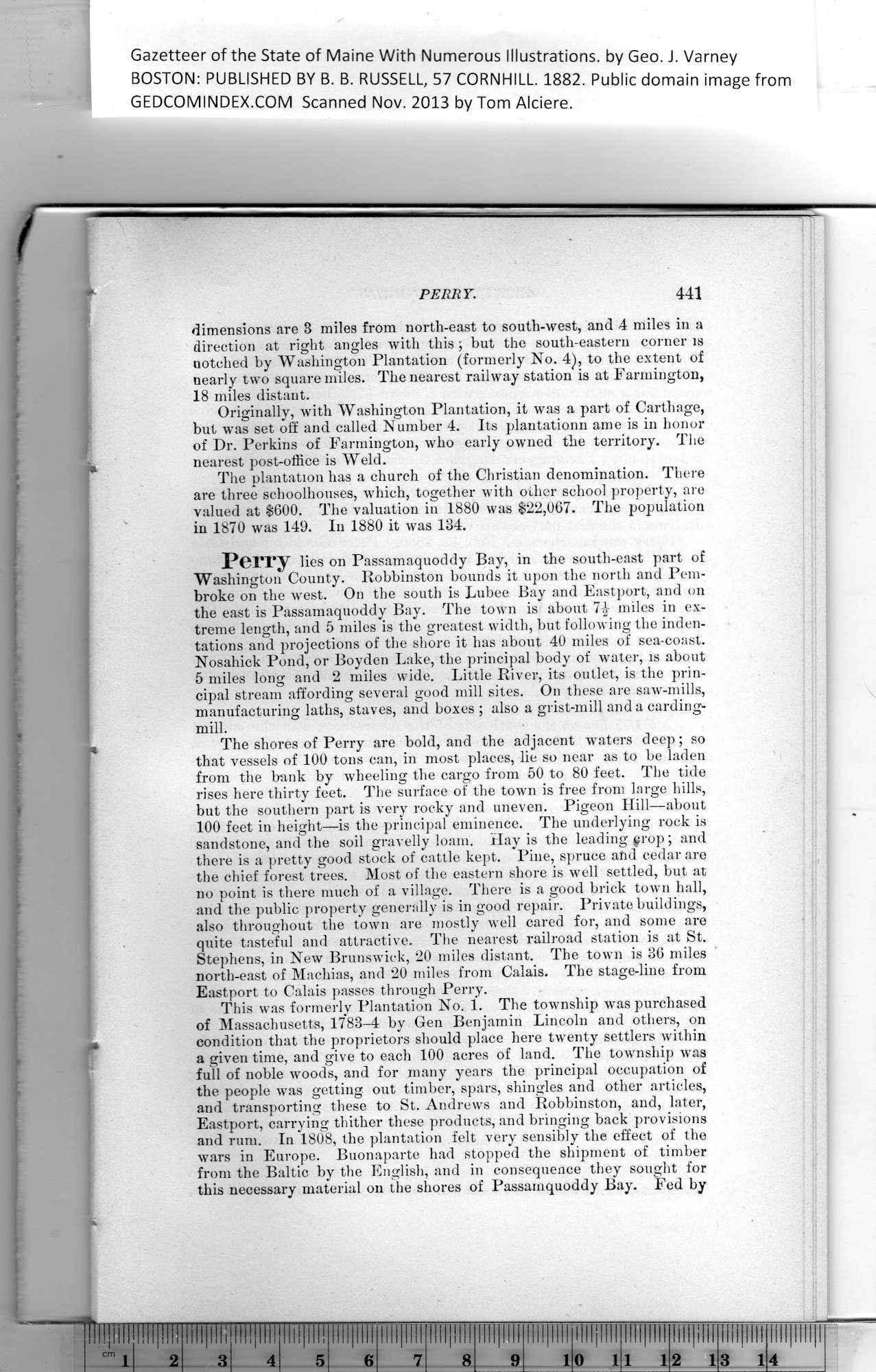dimensions are 3 miles from north-east to south-west, and 4 miles in a
direction at right angles with this ; but the south-eastern corner is
notched by Washington Plantation (formerly No. 4), to the extent of
nearly two square miles. The nearest railway station is at Farmington,
18 miles distant.
Originally, with Washington Plantation, it was a part of Carthage,
but was set off and called Number 4. Its plantationn ame is in honor
of Dr. Perkins of Farmington, who early owned the territory. The
nearest post-office is Weld.
The plantation has a church of the Christian denomination. There
are three schoolhouses, which, together with other school property, are
valued at $600. The valuation in 1880 was $22,067. The population
in 1870 was 149. In 1880 it was 134.
Perry lies on Passamaquoddy Bay, in the south-east part of
Washington County. Robbinston bounds it upon the north and Pem-
broke on the west. On the south is Lubee Bay and Eastport, and on
the east is Passamaquoddy Bay. The town is about miles in ex-
treme length, and 5 miles is the greatest width, but following the inden-
tations and projections of the shore it has about 40 miles of sea-coast.
Nosahick Pond, or Boyden Lake, the principal body of water, is about
5 miles long and 2 miles wide. Little River, its outlet, is the prin-
cipal stream affording several good mill sites. On these are saw-mills,
manufacturing laths, staves, and boxes ; also a grist-mill and a carding-
mill.
The shores of Perry are bold, and tbe adjacent waters deep; so
that vessels of 100 tons can, in most places, lie so near as to be laden
from the bank by wheeling the cargo from 50 to 80 feet. The tide
rises here thirty feet. The surface of the town is free from large bills,
but the southern part is very rocky and uneven. Pigeon Hill—about
100 feet in height—is tbe principal eminence. The underlying rock is
sandstone, and the soil gravelly loam. Hay is the leading grop; and
there is a pretty good stock of cattle kept. Pine, spruce and cedar are
the chief forest trees. Most of the eastern shore is well settled, but at
no point is there much of a village. There is a good brick town hall,
and the public property generally is in good repair. Private buildings,
also throughout the town are mostly well cared for, and some are
quite tasteful and attractive. The nearest railroad station is at St.
Stephens, in New Brunswick, 20 miles distant. The town is 36 miles
north-east of Machias, and 20 miles from Calais. The stage-line from
Eastport to Calais passes through Perry.
This was formerly Plantation No. 1*. The township was purchased
of Massachusetts, 1783-4 by Gen Benjamin Lincoln and others, on
condition that the proprietors should place here twenty settlers within
a given time, and give to each 100 acres of land. The township was
full of noble woods, and for many years the principal occupation of
the people was getting out timber, spars, shingles and other articles,
and transporting these to St. Andrews and Robbinston, and, later,
Eastport, carrying thither these products, and bringing back provisions
and rum. In 1808, the plantation felt very sensibly the effect of the
wars in Europe. Buonaparte had stopped the shipment of timber
from the Baltic by the English, and in consequence they sought for
this necessary material on the shores of Passamquoddy Bay. Fed by
mpipiiiiiiir
1 12 1
0 1
PREVIOUS PAGE ...
NEXT PAGE
This page was written in HTML using a program written in Python 3.2
